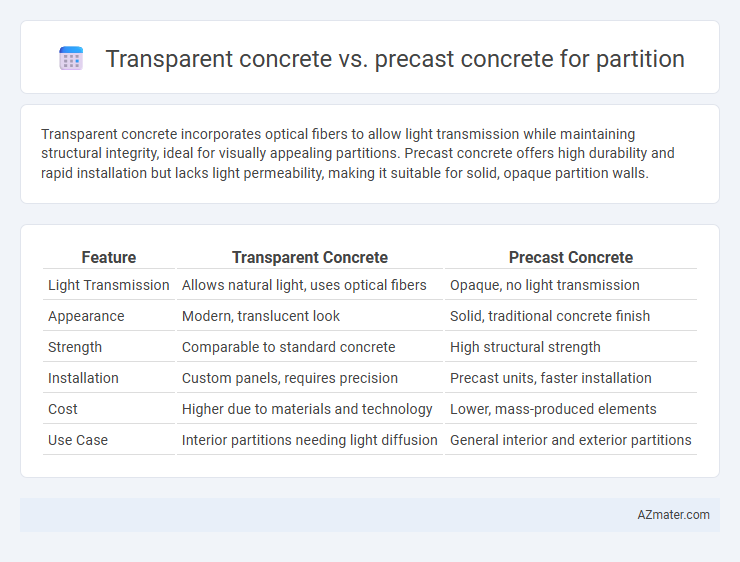Transparent concrete incorporates optical fibers to allow light transmission while maintaining structural integrity, ideal for visually appealing partitions. Precast concrete offers high durability and rapid installation but lacks light permeability, making it suitable for solid, opaque partition walls.
Table of Comparison
| Feature | Transparent Concrete | Precast Concrete |
|---|---|---|
| Light Transmission | Allows natural light, uses optical fibers | Opaque, no light transmission |
| Appearance | Modern, translucent look | Solid, traditional concrete finish |
| Strength | Comparable to standard concrete | High structural strength |
| Installation | Custom panels, requires precision | Precast units, faster installation |
| Cost | Higher due to materials and technology | Lower, mass-produced elements |
| Use Case | Interior partitions needing light diffusion | General interior and exterior partitions |
Introduction to Transparent Concrete and Precast Concrete
Transparent concrete, also known as light-transmitting concrete, incorporates optical fibers or resin-based translucent materials to allow natural light to pass through, enhancing interior lighting while maintaining structural strength. Precast concrete is manufactured by casting concrete in reusable molds off-site, then curing it under controlled conditions to ensure high quality, precision, and accelerated construction. Both materials serve diverse partition applications, with transparent concrete offering aesthetic and lighting benefits and precast concrete providing efficient, durable, and customizable partition solutions.
Composition and Material Differences
Transparent concrete incorporates optical fibers embedded within a cementitious matrix, enabling light transmission while maintaining structural integrity, whereas precast concrete consists primarily of traditional cement, aggregates, and reinforcement, molded and cured off-site for uniformity. The optical fibers in transparent concrete are typically made from glass or plastic, creating a unique composite that balances translucency and strength, contrasting with precast concrete's opaque and denser composition designed for load-bearing and durability. These material differences impact applications, with transparent concrete offering aesthetic and lighting advantages for partitions, while precast concrete emphasizes robustness and ease of installation.
Manufacturing Processes Compared
Transparent concrete is produced by embedding optical fibers or light-transmitting elements into the concrete matrix, requiring precise alignment and specialized molds during the casting process, which significantly increases manufacturing complexity and cost compared to traditional methods. Precast concrete partitions are manufactured in controlled factory environments using standard molds, allowing for consistent quality, faster production, and easier integration of reinforcement and inserts. While transparent concrete demands advanced technology for light transmission properties, precast concrete emphasizes scalability and structural reliability in partition production.
Aesthetic and Design Flexibility
Transparent concrete offers unique aesthetic advantages by integrating light-transmitting elements, creating illuminated partitions that enhance spatial experience with natural light diffusion. Precast concrete provides superior design flexibility through customizable shapes, textures, and finishes, allowing intricate patterns and large-scale modular applications. Combining transparent concrete's light-permeable quality with precast concrete's structural versatility results in innovative partition solutions that meet both functional and artistic demands.
Structural Performance and Strength
Transparent concrete, incorporating optical fibers or resin-based elements, offers moderate compressive strength suitable for non-load-bearing partitions, emphasizing light transmission over structural capacity. Precast concrete partitions exhibit superior structural performance with high compressive strength typically ranging from 25 to 40 MPa, providing robust load-bearing capabilities and enhanced durability. While transparent concrete excels in aesthetic and daylighting benefits, precast concrete delivers unmatched strength and stability for partition walls in commercial and industrial applications.
Light Transmission and Energy Efficiency
Transparent concrete enhances light transmission by integrating optical fibers or light-transmitting elements, allowing natural daylight to penetrate partition walls, which reduces reliance on artificial lighting and improves energy efficiency. In contrast, precast concrete partitions provide solid opacity with minimal light passage, necessitating increased use of electrical lighting and potentially higher energy consumption. The selective use of transparent concrete in interior partitions can significantly optimize building energy performance by balancing structural integrity with daylight harvesting.
Installation and Construction Time
Transparent concrete significantly reduces installation and construction time compared to precast concrete partitions because it combines structural strength with light transmission in a single panel, eliminating the need for additional fixtures or light adjustments. Precast concrete requires more extensive on-site assembly, including alignment, joint sealing, and often additional finishing steps, which extend the overall construction timeline. The lightweight nature and modularity of transparent concrete panels facilitate quicker handling and faster installation, optimizing project schedules in commercial and architectural applications.
Cost Analysis and Budget Considerations
Transparent concrete typically incurs higher initial costs compared to precast concrete due to specialized materials like optical fibers embedded within. Precast concrete offers more budget-friendly solutions with faster installation and standardized production, reducing labor and time expenses. Evaluating long-term benefits, transparent concrete can add value through aesthetic appeal and natural light diffusion, potentially offsetting upfront investment in specific architectural projects.
Durability and Maintenance Needs
Transparent concrete offers moderate durability with embedded optical fibers that maintain structural integrity while allowing light transmission, but it requires cautious handling to avoid fiber damage during installation. Precast concrete partitions provide superior durability due to dense compaction and controlled curing, resulting in enhanced resistance to wear, weathering, and impact. Maintenance for transparent concrete involves careful cleaning to preserve light permeability, whereas precast concrete demands minimal upkeep, typically limited to surface sealing and occasional inspections.
Best Applications for Partition Walls
Transparent concrete, embedded with optical fibers, offers unique design opportunities for partition walls by allowing natural light transmission while maintaining structural integrity, making it ideal for modern office spaces and retail environments seeking enhanced aesthetics and daylight usage. Precast concrete excels in creating durable, sound-insulating partition walls for industrial and commercial buildings due to its high strength, quick installation, and cost-effectiveness. Choosing transparent concrete suits spaces prioritizing visual connection and light diffusion, whereas precast concrete is better for functional separation and acoustic control.

Infographic: Transparent concrete vs Precast concrete for Partition
 azmater.com
azmater.com